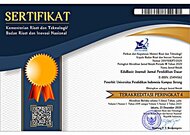Analisis Kemampuan Memecahkan Masalah Matematika Materi Debit Pada Kelas V Sekolah Dasar
Abstract
Keywords
Full Text:
PDFReferences
Adjie, N., & Maulana. (2006). Pemecahan Masalah Matematika. Bandung: UPI Press.
Darminto B. P. (2019). Analisis kesalahan mahasiswa dalam menyelesaikan soal sistem persamaan non-linear berdasarkan Teori Newman. Proseding Sendika, 5(1), 67-71. Diakses dari http://eproceedings.umpwr.ac.id/index.php/sendika/article/view/639/541.
Fatahillah, A., Wati, Y. F., & Susanto, S. (2017). Analisis kesalahan siswa dalam menyelesaikan soal cerita matematika berdasarkan tahapan Newman beserta bentuk scaffolding yang diberikan. Kadikma, 8(1), 40-51.
Fathurahman, P. (2011). Metode Penelitian Pendidikan. Bandung: Pustaka Setia.
Kania, N. & Arifin, Z. (2019). Analisis Kesulitan Calon Guru Sekolah Dasar Dalam Menyelesaikan Soal Pemecahan Masalah Matematis Berdasarkan Prosedur Newman. Supremum Journal of Mathematics Education, 3(1), 57-66.doi: 10.31235/osf.io/brwgs.
Kemendikbud. (2018). Senang Belajar Matematika (Buku Siswa). Jakarta: Kementerian Pendidikan dan Kebudayaan.
Kodariyati, L. & Astuti, B. (2016). Pengaruh modul PBL terhadap kemampuan komunikasi dan pemecahan masalah matematika peserta didik kelas V SD. Jurnal Prima Edukasia, 4(1), 93-106. doi:10.21831/jpe.v4i1.7713 (diakses pada tanggal 10 oktober 2019).
Mahmudah, W. (2018). Analisis kesalahan siswa dalam menyelesaikan soal matematika bertipe Hots berdasar Teori Newman. Unisda Journal of Mathematics and Computer Science, 4(1), 49-56.
Mairing, J. P. & Aritonang, H. (2018). Penyelesaian masalah matematika berakhir terbuka pada siswa SMA. Fibonacci: Jurnal Pendidikan Matematika dan Matematika, 4(1), 61-70. doi.org/10.24853/fbc.4.1.61-70.
Mursidik, E. M., Samsiyah, N., & Rudyanto, H. E. (2014). Analisis kemampuan berpikir kreatif peserta didik dalam memecahkan masalah matematika open-ended ditinjau dari tingkat kemampuan matematika. Jurnal Penelitian LPPM IKIP PGRI
Madiun, 2(1), 7-13. (diakses pada tanggal 13 Oktober 2019 dari http://e-journal.unipma.ac.id/index.php/JP-LPPM/article/view/344)
Newman, M. A. (1977). An analysis of sixth-grade pupils’ errors on written mathematical tasks. Victorian Institute for Educational Research Bulletin, 39, 31-43.
Oktaviana, D. (2017). Analisis tipe kesalahan berdasarkan Teori Newman dalam menyelesaikan soal cerita pada mata kuliah matematika diskrit. Edu Sains: Jurnal Pendidikan Sains & Matematika, 5(2), 22-32. doi.org/10.23971/eds.v5i2.719 .
Ramdhantri, I., Achmad, A., Sukoco, A., & Suryansari, K. C. (2018). Error analysis of students in grade VI of Bumirejo Elementary School 1 in completing flowchart debit story problem. Social, Humanities, and Educational Studies (SHEs): Conference Series, 1(2), 208-216. doi.org/10.20961/shes.v1i2.26854. (diakses pada tanggal 10 Oktober 2019).
Roebyanto, G. & Harmini, S. (2017). Pemecahan Masalah Matematika untuk PGSD. Bandung: PT Remaja Rosdakarya.
Romaika & Amalia, Y. (2014). Analisis kemampuan pemecahan masalah matematika peserta didik pada materi bangun ruang sisi datar dengan Teori Van Hiele. Jurnal Bina Gogik, 1(2), 17-31.
Saptorini, K. (2019) Ringkasan Matematika SD: Panduan Lengkap dan Praktis. Bandung: Sasmita Ganesha Utama
Sari, R. M. (2018). Pengembangan Media Komik Matematika Materi Debit pada Siswa Kelas V Sekolah Dasar. Skripsi. Malang: Pendidikan Guru Sekolah Dasar. Fakultas Keguruan dan Ilmu Pendidikan. University of Muhammadiyah Malang. Diakses pada tanggal 28 April 2020 dari http://eprints.umm.ac.id/id/eprint/39335.
Sundayana, R. (2014). Media dan Alat Peraga Dalam Pembelajaran Matematika. Bandung: Alfabeta.
Susanto, A. (2013). Teori Belajar dan Pembelajaran Di Sekolah Dasar. Jakarta: Prenada Media Group.
DOI: https://doi.org/10.17509/ebj.v2i2.27211
Refbacks
- There are currently no refbacks.
Copyright (c) 2020 Universitas Pendidikan Indonesia
This work is licensed under a Creative Commons Attribution 4.0 International License.
This journal is indexed by




.png)




.png)
1.png)


1.png)

.png)